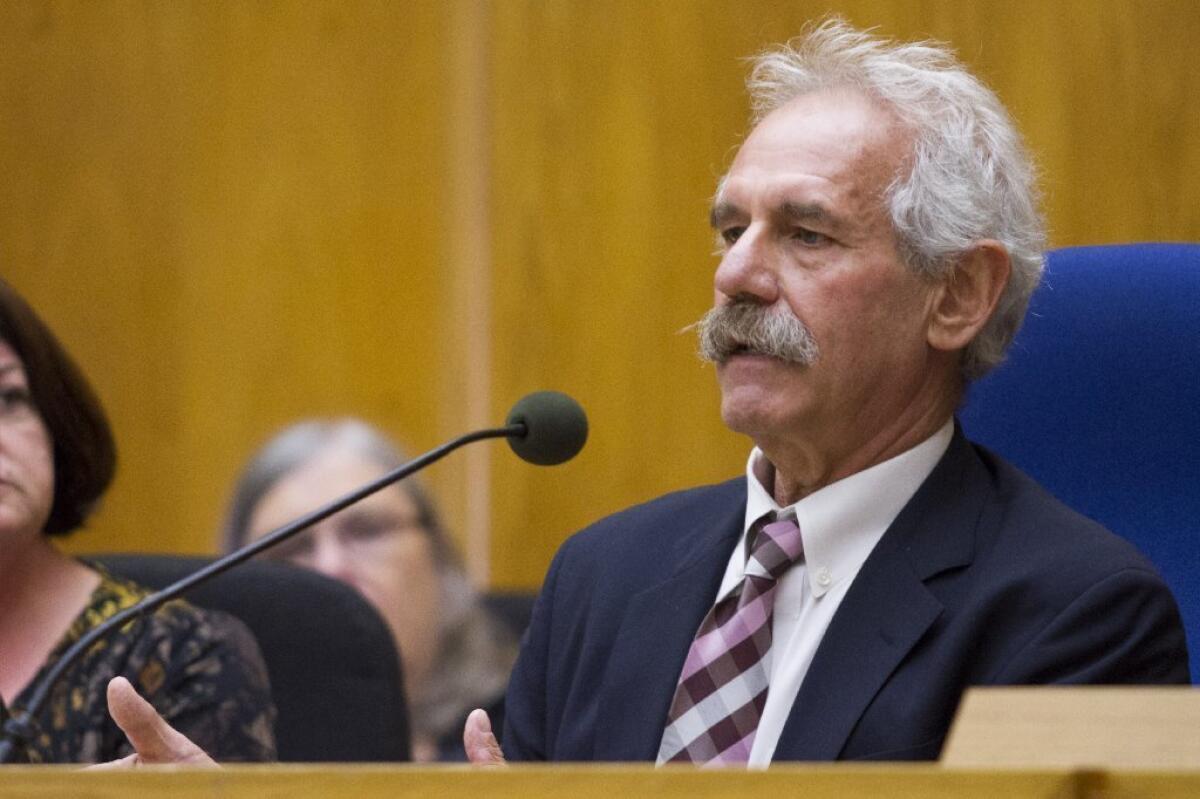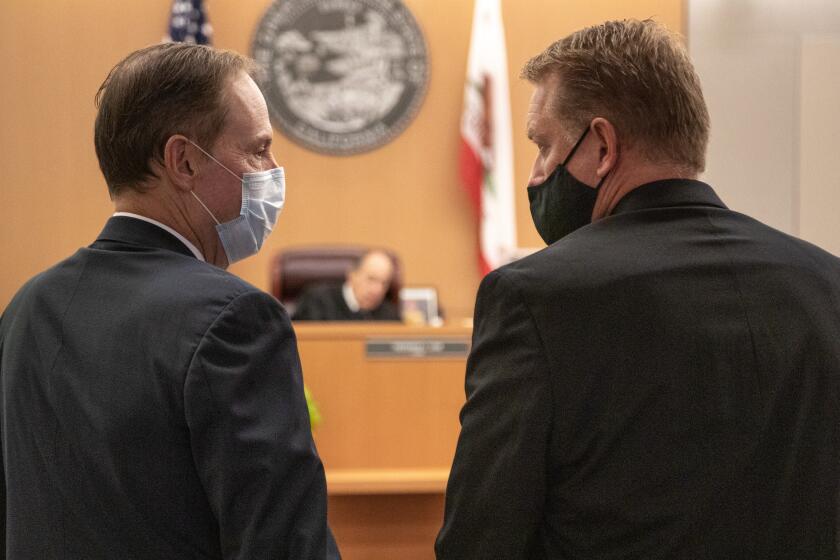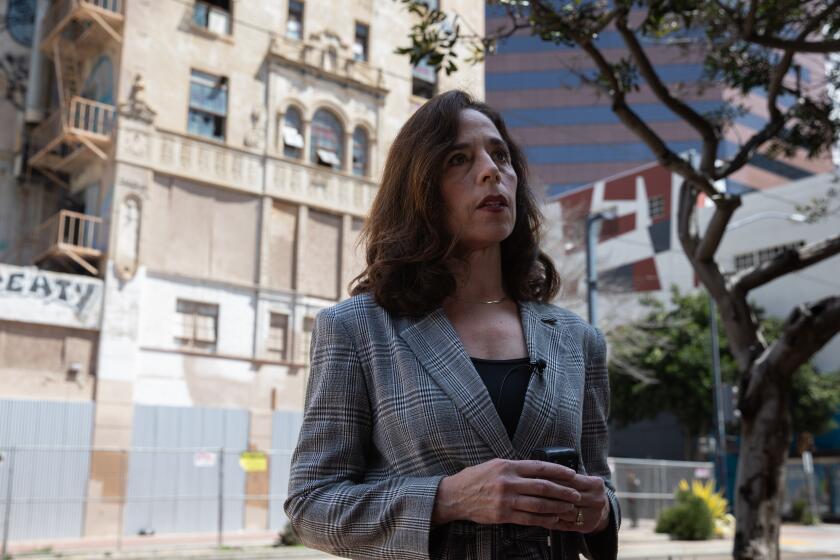CPUC meets with Wall Street types, too
Critics say it’s part of the same problem as backchannel dealings with utilities

State electricity regulators have accepted frequent meetings with Wall Street analysts and hedge fund investors, often discussing pending matters with direct bearing on the value of utility stocks.
The meetings may indicate that California Public Utilities Commission members do a thorough job overseeing a significant sector of the California economy. But critics say the discussions raise a now-familiar question — whose side is the PUC on?
The commission is already under scrutiny for its backchannel dealings with utility executives, seeking $12 million for criminal defense attorneys to help respond to ongoing investigations of apparently close ties. Little attention has been paid to the undisclosed Wall Street meetings as a secondary level of commission activity affecting the companies.
Latest: CPUC
- Consumer group builds PUC email database
- AG says CPUC probe hasn't stalled
- State to reopen $4.7 billion San Onofre deal
- CPUC meets with Wall Street types, too
- Consumer attorney raises question: Whose side is the attorney general on?
- CPUC now wants $12.3 million for legal fees
MORE WATCHDOG
“We need private investment in California utilities to build and upgrade infrastructure,” commission spokeswoman Terrie Prosper said. “Low interest rates help keep those costs down for consumers, and a clear understanding of California’s policy goals helps investors to better understand the utility and our policies that the utilities must follow.”
Utilities also say conversations between commissioners and investors help to keep costs down for customers.
“Regulators want to know how Wall Street views the utilities’ financial stability and the regulatory environment in California,” said Stephanie Donovan of San Diego Gas & Electric. “A positive assessment can directly benefit utility customers, because a good credit rating can mean a lower cost of debt and can also affect other factors that help to determine utility rates and customer bills.”
Even a fractional percentage change in interest rates can make a huge difference in costs to utilities — and ratepayers.
Sempra Energy, parent company to San Diego Gas & Electric, carries almost $5.2 billion in long-term debt in notes with interest rates that vary from 2.3 percent to 9.8 percent, according to its most recent U.S. Securities and Exchange Commission annual filing.
If Sempra restructured the $500 million note coming due in 2019 from 9.8 percent to a lower rate, the company could shave millions of dollars off its long-term debt.
As part of the process of overseeing a monopoly with regulated rates, commissioners have a responsibility to allow the companies a fair return on their investments. But consumer advocates and former regulators say the commission may have taken that responsibility too far — and too far outside the public view.
“California regulators have lost their way,” said Loretta Lynch, a former utilities commission president who has become a sharp critic of the board since her term expired in 2004. “They care more about government artificially propping up the utility stock prices than about ensuring adequate services at just and reasonable prices for actual ratepayers.”
Blurred lines
Documents collected by The San Diego Union-Tribune in recent months show that commissioners and analysts are aware of a prohibition against talking about pending cases, but the line between discussing general policy issues and more specific proceedings can get blurry.
Before one 2013 meeting with then-Commissioner Mark Ferron, an aide to Wall Street analyst Greg Gordon told the commissioner’s staff that he wanted to discuss “the legal framework regarding the CPUC's ability and flexibility to implement fines and penalties.”
At the time, Ferron was among those considering a major fine against Pacific Gas & Electric, which owned a pipeline that exploded in San Bruno, killing eight people.
By then, the commission also was investigating the January 2012 failure of the San Onofre nuclear plant in San Diego County, which resulted in $3.3 billion of premature shutdown costs billed to ratepayers. A flawed steam generator manufactured by Mitsubishi was to blame.
In an email eight months after the San Onofre shutdown, an employee at the investment bank Morgan Stanley explained to a commission aide that one of their experts wanted to meet with commissioners on a number of issues.
“What’s been the hold up for the rate case of Sempra utilities and SCE?” the analyst asked, referring the parent company of San Diego Gas & Electric and to Southern California Edison. “Where do we stand with the various (investigations) and (rulemaking)” for San Bruno? “(Edison) may have to rebuild steam generators and receive limited recovery from (insurers) or Mitsubishi. Full recovery of (capital expenditures) and replacement power costs?”
Ferron took the meeting, and received a thank you note the following day.
“The investors on the trip all expressed to me their appreciation for your time, and for the dialogue on the topics of greatest interest to the investing community,” the Morgan Stanley executive wrote in an email.
After one delegation of Wall Street firms met with Ferron and other regulators in 2012, Morgan Stanley issued an upbeat assessment of California utilities.
“The key takeaway from our meeting with all commissioner offices at the CPUC is that regulation will remain balanced,” the Morgan Stanley researcher told his clients. “We expect (returns on equity) to remain above-average with supportive rate-case resolution this quarter.”
Ferron, who resigned from the commission in 2014 for health reasons and was appointed to the governing board that oversees the state power grid last year, did not respond to requests for comment.
‘Advance information’
At least five current and former commissioners took meetings or exchanged private communications with investment professionals in recent years, records show.
In May 2014, Commissioner Michel Florio met for an hour with a representative from New York analyst Wolfe Research. Records show the firm wanted “to discuss California regulatory environment, safety issues and renewable standards.”
The day after that, Florio had an hourlong “general discussion with Moody’s Investors Service on issues that may affect electric utilities, credit quality,” according to his calendar.
Charlie Harak, who runs the energy unit of the National Consumer Law Center, said there is little reason for institutional investors or rating agency analysts to meet with commissioners other than to gain inside information.
“When a regulator asserts that meeting with rating agencies is good for the consumer, they are almost always signaling that they are giving advance information inappropriately to those rating agencies about how the commission will act in the future,” he said. “Otherwise, it likely wouldn’t affect the bond rating.”
Jim Rossi, a Vanderbilt University law professor who researches the energy sector, said in many public utility contexts regulators are required keep a keen eye on interest rates, capital markets and the rate of return for the sectors and firms that they regulate.
“This is important to ensuring that regulators allow utilities to recover the cost of capital associated with their activities — such as for example building a new transmission line to serve customers — and is a constitutional requirement in the calculation of regulated rates,” he said. “One would hope that in looking to such information regulators are systematically examining credible sources of market information, and not on ad hoc or selective information.”
Two regulators from other states said the meetings themselves do not indicate California is an outlier in terms of its dealings with Wall Street, but the subject matter and posture of the participants would be important, as would the frequency.
“It’s totally appropriate for commissioners to try to understand the financing aspect of the utilities industry and to take meetings with people who have insights into that,” said former Illinois Commerce Commission member John Colgan. “But even if I was in a meeting like that, I wouldn’t be sharing what I think. I would be asking questions.”
Nancy Brockway served on the New Hampshire Public Utilities Commission between 1998 and 2003. She said she met with rating agencies once or twice over those five years and made sure to invite a consumer representative to promote fairness.
Brockway said when hedge funds and institutional investors request private meetings, they are generally seeking information that is outside the public realm.
“It is legal and ethical, but the public can draw what conclusions it wants from the choice of who gets to meet informally,” she said.
The view from outside
Scheduling a meeting with California utility regulators has proved elusive for Martin Homec, a Davis lawyer fighting the commission’s push toward so-called smart meters.
“They’re playing favorites,” Homec said. “They say they are considering Wall Street’s costs, but they won’t hear our requests to discuss the cost of smart meters and the whole electric system on people’s health.”
Homec said commissioners should be required to report their meetings with investors the same way other participants in commission proceedings are required to disclose communications they have with regulators.
“It is part of the process and it should be part of the record,” he said. “It shouldn’t just be a commissioner talking in private with some Wall Street guy.”
Rochelle Becker, co-founder of the Alliance for Nuclear Responsibility nonprofit, said regulators should base decisions on information in the public record, not on private discussions.
“I fail to understand what these Wall Street types have to communicate that should not be said in public,” she said. “That way, there would be some way to vet the accuracy of what’s told to the CPUC.”
Criminal investigation
In spring 2014, as thousands of emails related to the San Bruno pipeline disaster were close to being released publicly, then-President Michael Peevey of the utilities commission sent a brief note to longtime friend Gavin Wolfe, who was then a managing director at Bank of America Merrill Lynch.
Peevey asked Wolfe to meet with Michael Picker, the former political consultant and adviser to Gov. Jerry Brown who succeeded Ferron on the utilities commission.
“Please extend him every courtesy, including, I suggest, setting up a luncheon or other meeting with him and several of your colleagues, not only from BofA, but other investment houses,” Peevey wrote.
The Peevey introduction set the stage for a two-day “roadshow” for Picker across New York City, according to internal commission emails. Picker met privately and in group settings with more than 30 global investors, analysts and wealth managers with interests before commission.
Two months after the New York visits, following a private meeting in Sacramento with an executive from the global financial-services firm UBS, Picker asked if his guest was satisfied with the discussion.
“Did it do what you needed?” Picker wrote in an email to Julien Dumoulin-Smith, an executive director for UBS Investment Bank.
“Absolutely, I always appreciate your insight; refreshing change from a lot of folks we meet with,” Dumoulin-Smith responded few hours later.
Picker was named commission president in late 2014, after Peevey announced he would not seek a third six-year term on the utilities commission.
This past April, after Picker’s commission issued a $1.6 billion fine against PG&E for the San Bruno explosion, a Moody’s analysis called the penalty “a credit positive.” Standard & Poor’s raised the company’s outlook from “negative” to “stable.”
Get Essential San Diego, weekday mornings
Get top headlines from the Union-Tribune in your inbox weekday mornings, including top news, local, sports, business, entertainment and opinion.
You may occasionally receive promotional content from the San Diego Union-Tribune.












